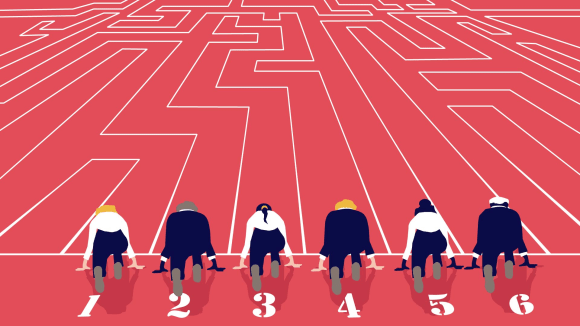
Latest
-

New study suggests major productivity boost when using Cursor’s coding agent
Is this the massive productivity benefit we’ve been waiting for?
-
The unseen fixes that boost engineering performance
At the intersection of toil and operational risk lies “perilwork.”
-
In partnership with Uplevel
How to spot and unblock engineering bottlenecks
Learn how your team can identify and fix what’s really slowing them down.
-
 In partnership with LaunchDarkly
In partnership with LaunchDarklyFrom code tsunami to controlled innovation: Launching software in the age of AI
How to harness the explosive speed of AI-driven development without losing control, compromising safety, or putting customer experience at risk.
Editor’s picks
Productivity isn’t always fast
It can often feel like we aren’t being productive unless we’re working at max speed. But slow productivity is here to subvert that idea.
How to speed up code reviews
Code reviews don’t have to be painful. Here’s how to embrace tools and more collaborative processes to raise the bar on your review cycle.
Maintain team performance during unexpected change
You’ll have to experience change management at least once in your career. Make sure your teams can maintain performance through it all.

Deadline: January 4, 2026
Call for Proposals for London 2026 is open!
Essential reading

Should the daily stand-up die?
Will the real agile developers please stand up? Please stand up. Please, stand up.
On our Velocity playlist

Engineering owns velocity
In this talk, I’ll explore what engineering leaders need to do to credibly own velocity and deeply align their work with the company strategy.

Launching a Gen AI powered travel companion: A case for tiger teams
Explore Booking.com’s journey in launching a Gen AI travel companion in 3 months, powered by a tiger team approach for rapid, focused product development and innovation.

Goldilocks doesn’t need your story points or your t-shirts
Ben Murray believes there is only really one question you need to ask: is this task small enough?

How to drive pace in your team ??♀️
Alicia Collymore delivers actionable advice that’ll help you to improve your teams’ delivery and pace without a data-first approach.

Planning for success when scaling rapidly
Create goals, prioritize effectively, set expectations, and drive alignment.
More about Velocity
-
Researchers say generative AI isn’t replacing devs any time soon
Can large language models solve complex software engineering tasks? Not yet according to a recent study.
-
How to speed up code reviews
Code reviews don’t have to be painful. Here’s how to embrace tools and more collaborative processes to raise the bar on your review cycle.
-
How to keep engineering teams effective through prioritization
As an engineering leader, guiding your teams on what to prioritize it paramount for impactful work.
-
Unlocking productivity with developer platforms
Developer platforms can be a potent tool for your teams. Learn how to improve productivity with knowledge reuse and more!
-
Managing the chaos of context switching
It’s time to examine the good, the bad, and the very ugly elements of context switching. Even better, we’ll take a look at some strategies for managing it.
-
If agile isn’t dead, why is it still not working?
Agile software development has outlived wave after wave of technology innovation, but in 2023, is the methodology on life support?
-
Introducing processes where none exist
Introducing processes to a team as a new manager can seem daunting. Learn how to mitigate pushback and reach team harmony with these tips.
-
Building a prioritization framework
During key planning periods, it’s important for engineering managers to ruthlessly prioritize projects for their teams. Here are some frameworks to help you get there.
Top Velocity videos
-

Increase the opportunity for success and diversity in your software engineering teams through professional apprenticeships
Marco Zanchi explores the challenges posed by the skills shortage and the pivotal role professional apprenticeships play in bridging the gap with the most important asset of any organisation: its people.
-
Why full SDLC testing matter in your software development lifecycle
Quality and velocity” is no longer an “either-or” statement. To accommodate the demands for speed and quality, many companies today are trying to test every change using different tools throughout the software lifecycle, but the tools are isolated and don’t inform each other of a holistic strategy for quality. Thus, testing becomes a bottleneck, and it can result in fewer releases with no improvement to the customer experience. Join Sangit Patel to learn how a holistic approach can help address these market challenges.
-

Building bridges: The art of crafting seamless partnerships between engineering, product, and design
James Stanier, Winter Wei, and Janet Balneaves join us for a panel discussion on the art of crafting seamless partnerships between engineering, product, and design.
-

Maps to medicines: One map to an atlas
Shweta Bhandare discusses how Recursion scientists perform CRISPR-Cas9 mediated knockout to understand the activity level of every gene in a specific disease model, which allows new discoveries to be made. These maps are specific to a cell-type.
-

Building a shared vision: Creating alignment across autonomous teams
Maria Neumayer’s talk will explore how to overcome these challenges, get buy-in from engineers to promote cross-team collaboration and alignment, all while establishing and refining shared standards and working towards a shared vision.
-

How to drive pace in your team ??♀️
Alicia Collymore delivers actionable advice that’ll help you to improve your teams’ delivery and pace without a data-first approach.
-

Where we’re going wrong with developer productivity
Cat Hicks proposes a different, science-backed approach to productivity using research evidence from a study with 1200+ developers: developer thriving.
-

Compassionate on-call
Lisa Karlin Curtis discusses how to build a compassionate on-call rota, and how that can help build sustainable and high performing teams.

